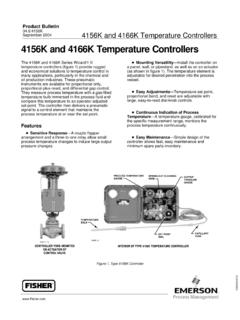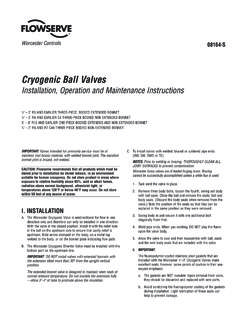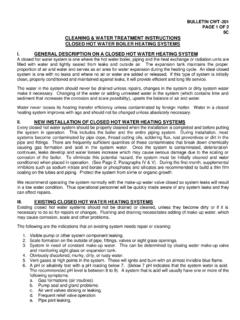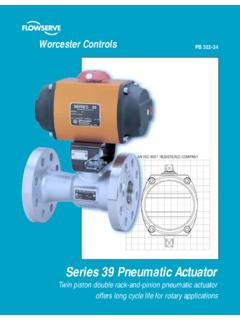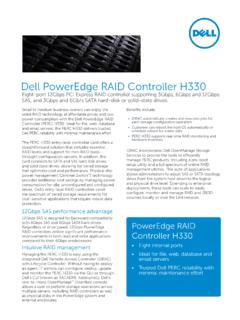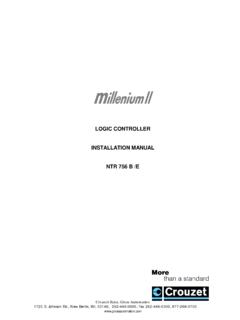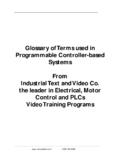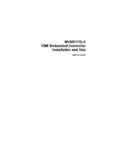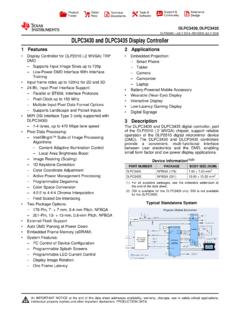Transcription of Model 43AP Pneumatic Controller, Style B - CEXI
1 MI 011-476. Instruction January 1980. Model 43ap Pneumatic controller , Style B. Installation and Operation Model 43ap controller continuously detects the difference between a process measurement and its set point, and produces an output air signal that is a function of this difference and the type of control. The output signal is transmitted to a control valve or other control device. The process measurement, set point, and output signal are indicated on the controller . A Siebe Group Company MI 011-476 January 1980 Principle of Operation Standard Specifications Types of Control Suffix Code A1: On-Off A2: Proportional A3: Proportional plus Derivative A4: Proportional plus Reset A5: Proportional plus Reset plus Derivative A7: Differential Gap A8: Automatic Shutdown Control Limits Proportional: 4 to 400%.
2 Reset: to 50 minutes per repeat Derivative: to 50 minutes Differential Gap: 1 to 100%. Output Signal: 3-15 psi or 20-100 kPa Air Supply: 20 psi (140 kPa). Air Consumption: std ft3/min ( std m3/h). Air Connections: Tapped for 1/4 NPT. Ambient Temperature Limits: 40 to +180 F ( 40 to +80 C). Weight: Approx. 10 lb ( kg), excluding element Case: Glass fiber reinforced plastic Principle of Operation 1. A differential linkage measures difference between measurement pointer and setting index positions. This error signal moves proportioning lever. 2. Proportioning lever pivots at its center on end of a flat spring. 3. This motion changes flapper nozzle relationship, causing relay to establish an output pressure.
3 4. Output pressure is fed back to proportioning bellows, which acts through proportioning lever to rebalance flapper nozzle. 5. Reset bellows and tank assembly are used when measurement must be maintained exactly at control point (without offset ). 6. Derivative tank assembly is used to improve system response to a slow process. 2. Principle of Operation MI 011-476 January 1980. controller with Proportional, Reset, and Derivative Actions, and Automatic-Manual Transfer System (Optional). Proportional Control For description, see Items 1 through 4 above. 3. MI 011-476 January 1980 Principle of Operation On-Off Control On-off control is obtained by pivoting the proportional lever about a fixed point without propor- tioning or reset bellows.
4 This controller can be equipped with an automatic shutdown unit. Differential Gap Control Differential gap control is obtained with positive 4. Installation MI 011-476 January 1980. Installation controller Mounting Mount controller level on a rigid support. If controller has Type 37 Meter, see page 8. Flush Mounting After case is inserted in panel, install mounting brackets as shown. Slide brackets firmly against panel and tighten bracket bolts to case. in mm Surface Mounting Loosely install mounting brackets flush with rear of case as shown. Attach brackets to panel with 1/4-inch bolts or #14 wood screws. Tighten mounting bracket bolts to case. in mm 5. MI 011-476 January 1980 Installation Pipe Mounting Remove mounting bracket from controller case.
5 Securely fasten bracket on a 2-inch or 3-inch pipe. Then reinstall controller into bracket. controller Dimensions and Connections Flush Mounting in mm Surface Mounting in mm 6. Installation MI 011-476 January 1980. Pipe Mounting in mm Pressure Connection 1/4 NPT female (up to 2000 psi or 14 MPa). 1/2 NPT male (above 2000 psi or 14 MPa). 9/16-18 Aminco (from 10000 psi or 70 MPa). Pneumatic Receiver Connection 1/4 compression fitting NOTE. When installing piping, hold case connections stationary with wrench. Optional Integral Filter-Regulator Set in mm Air Supply and Output Piping For Control Valve Piping see Instruction MI 012-210. 7. MI 011-476 January 1980 Installation ! WARNING. Air is usually used as controller operating gas, and it is vented directly from case.
6 If a hazardous1 gas is to be used instead, GTC option must be specified. This option provides a vent connection on case which can be used to pipe gas to a location classified for its dispersal. In addition, in normal operation some gas may bleed from case; therefore, classification of controller location must permit presence of this gas. 1. Air supply must be regulated at 20 psi (140 kPa). 2. controller uses about std ft3/min ( std m3/h) of air in normal operation. 3. Air must be clean and dry. Blow out filter regularly. 4. Air lines must be free of leaks. Mounting controller with Type 37 Meter 1. See Nat'l Elect'l Code, NFPA 70, Art. 500-517. 8. Installation MI 011-476 January 1980. Automatic-Manual Transfer System (optional).
7 The automatic-manual transfer system consists of a regulator, a sensitive balance indicator, and a transfer switch. The system permits switching between manual and automatic control without upsetting the process. The illustration below shows the components that are concerned with the transfer system. To Transfer from Manual to Automatic Control Slowly turn set point knob (or adjust remote set point, if present) to move balance indicator ball to within central portion of tube (not up against either end). Then turn switch to automatic (A). To Transfer from Automatic to Manual Control Turn regulator slowly to move balance indicator ball to within central portion of tube (not up against either end).
8 Turn regulator so that top of knob moves in direction that ball is to move. Then turn switch to manual (M). Valve can now be controlled with regulator. 9. MI 011-476 January 1980 Installation Automatic-Manual Transfer Using 2-Position Nozzle Seal Switch (optional). In place of the transfer system above, a 2-position nozzle seal switch is available. Moving this switch to the manual (M) position, seals the nozzle line causing the output to increase to the sup- ply pressure. The output can now be set to the desired value by reducing the pressure with an external supply regulator furnished by the user. To Transfer from Manual to Automatic Control Turn set point knob (or adjust remote set point, if present) so that set point index is in line with measurement pointer.
9 Move switch to automatic (A). Quickly increase air supply pressure to 20 psi (140 kPa). To Transfer from Automatic to Manual Operation Slowly reduce air supply pressure to output pressure, and move switch to manual (M). Valve can now be controlled with regulator. 10. Installation MI 011-476 January 1980. Putting Into Operation For on-off, differential gap, or automatic shutdown controllers, see page 14. 1. Make sure that measuring system is properly installed and operating. 2. Set control dial so that index points to desired control action (output either increases or decreases with increasing measurement). With latch in lowered position (as shown below), control dial cannot be accidentally rotated to area of reverse control action.
10 To reverse control action, push up latch and rotate dial so that latch is on other side of stop, then push down latch (see figure below). 11. MI 011-476 January 1980 Installation 3. Turn PROPORTIONAL BAND adjustment (on control dial) to 400 or to safe high value. Turn DERIVATIVE adjustment (if present) to Turn RESET adjustment (if present) to 50 or safe high value. 4. Open shutoff valves and close bypass valve. 5. Turn set point knob (or adjust remote set point, if present) so that set point index is at desired value. 6. If controller is not equipped with optional automatic-manual transfer, proceed to Step 7. If controller is equipped with transfer, start up in manual as follows: a. Move transfer switch to manual (see page 9).
